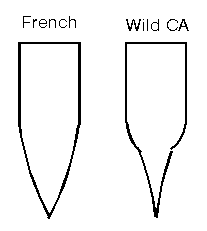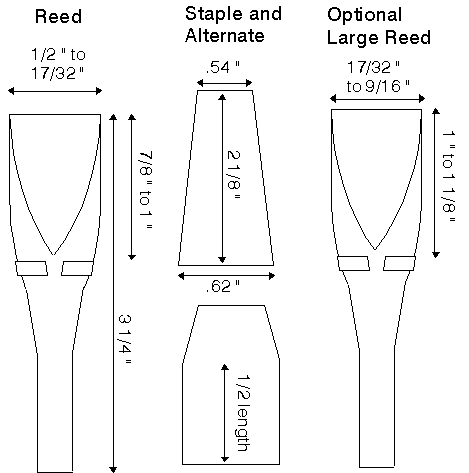
Copyright 2011 David C. Daye
Cane from different sources has different stiffness and formation properties, and this means that in order to end up with reeds that are equivalent when using different material, some elements of the head design need to be varied. Most makers stay with one source of cane, but there are significant differences in the cane among some different makers, and this is one reason we can find that reeds from different makers fit to the same chanter are sometimes noticeably different.
I have used 3 sources of cane for my reeds: French bassoon cane, Spanish bagpipe cane, and wild harvested California cane supplied by Sampson.
I made reeds for my own use for about 10 years before becoming a professional maker. In those days I had small amounts of Spanish cane from several makers, and a few pieces of wild California cane probably harvested by Ted Anderson. By chance I chose to test a French bassoon cane from Rigotti, which was fortunate because it is one of the softest French canes and more adaptable than some to uilleann pipes. It is meant for use in wet-blown woodwinds, and I thought this would make it ideal for the extremes of heat and humidity of the North American warmer months. Knowing that it was more resistant to forming during the construction phase, I felt it would therefore be equally resistant to unwanted deforming once in service. This proved true right away.
Some years later during experimental collaboration with the Australian maker Craig Fischer after I was in production of chanters and reeds, he and/or Michael O'Donovan devised a test of 3 dimensional properties of cane in order to understand more about the different sources of cane. They used a hardness meter to dent the cane with consistent force into the end grain, across the grain edgewise, and through the face of cane. The relative depths of the 3 dents varies with cane source; Craig told me that they found the Rigotti cane had the same 3D profile as Anderson's wild California cane and some old pieces that were made available from Leo Rowsome's shop.
It doesn't say that the quality is the same, only that these sources will settle into about the same general shape in a finished reed. This makes it easy to compare results of reeds made from these sources and of reed recipes intended for any of them.
The Rigotti cane has changed noticeably since then, making me suspect that they're using a different source or perhaps a line of new plants that have different properties. But it remains closer to its old behavior than to the Spanish and the Sampson California.
Tail shape is one of the design factors affecting the stresses and stability of reeds. French cane is very resistant to deformation, a wide rounded tail is helpful to create circular stresses that help form an open chamber above the staple and work against the considerable leverage of the staple in this cane, acting along the grain, tending to pry the lips closed. The wild cane deforming much more easily

| Property | French | Spanish | California |
| Upper Blade Volume |
Full | Medium | Shallow |
| Crossgrain Deformation |
Low | Medium | High |
| Along-Grain Deformation |
|||
| Base 2nd Octave Pitch |
OK | Flat | Flatter |
| Reed Initial LOA |
3 19/64 " | 3 1/16 " | 3 7/32 " |
The common .016" brass can easily be adapted to give a fuller chamber for sharper 2nd octave by gluing some .015" thick plastic or brass sheet onto one side of the squeezed upper end of a staple. This will thicken the outside of the staple to approximately the same thickness that older traditional .021" thick soft copper sheet staples would have.
.021" copper itself may be used for the Penny-Chanter staple, but contrary to the advice in the Penny-Chanter users' manual, for the Spanish and California canes you may find it helps to widen the staple blank to maintain the same internal bore size that the brass sheet has. I've found that adding .015" to the width of the staple blank over its entire length gives a copper staple that fits on my rolling mandrel about the same as a brass staple.

Use the upper straight tapered blank. Make the eye .555" wide and the base .635" wide. If your reeds are too sharp in the 2nd octave, trim the widths back nearer to the original staple's dimensions.